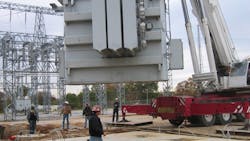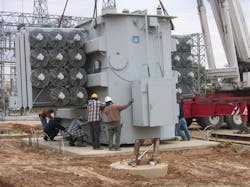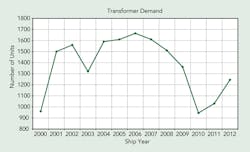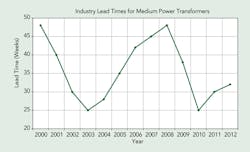Imagine being the person within an electric utility who is responsible for electric substations and the power transformers within them. The weather forecast calls for severe thunderstorms and tornadoes. That evening it begins to rain heavily. Lightning is flashing everywhere. The phone rings in the middle of the night. The foreman of the transformer maintenance group is on the other end of the line giving word that a power transformer has failed. Questions begin cascading through the mind: Is there a spare transformer available to use? Where is it located? How long will it take for crews to place the spare transformer in service?
Luckily, there is a spare stored at another substation across town. Problem solved.
Now the spare is going into service, but what if there is another failure? What are power transformer lead times, 52 weeks? A purchase that could approach a million dollars has to go through a large number of approvals before a purchase order can be issued. Instantly, prayers are said for good weather in hopes the phone does not ring again, at least for another year.
What if there was another easier way? What if one could just fill out a requisition and instantly have a purchase order with a transformer manufacturer? Better yet, what if the transformer manufacturer actually came to that person with available production slots within its plant? What if pricing levels for multiple years could be handled once on the front end?
Long Lead Times
It takes a long time to write the engineering specifications for a power transformer, prepare a requisition, send out bid invitations and evaluate bids. The process also has budget ramifications. With the long lead times on these steps, a two- or three-year budget is almost required. For a municipality, the purchasing process is dictated by law. Once a requisition is received in the purchasing department, the request for proposal is advertised and sent to various prospective bidders. The bidders are given four weeks to prepare their proposals. At the end of that period of time, bids are opened in a public forum.
The evaluation process then starts and can take up to 12 weeks depending on the complexity of the equipment being purchased. Once a recommendation has been received in purchasing, a three- to four-month process begins for approvals.
Memphis Light, Gas and Water Division (MLGW; Memphis, Tennessee, U.S.) answers to a board of commissioners. Expenditures above a certain amount also require the approval of the Memphis city council. Both approvals are required before an order for these expensive items can be placed. This means the total process to place an order for a power transformer can take up to 8 months.
Another Way
The good news is power transformers and other large lead-time items can be purchased much more quickly and easily. Strategic alliances help to make that possible. Strategic alliances are multiyear partnerships between the manufacturer and customer, where customer forecasts, planning data and other information are shared with the manufacturer, and developments in design and technology are shared with the customer. The award of a multiyear contract allows a customer to receive preferred pricing, and the manufacturer can offer firm pricing with escalation and de-escalation clauses.
The alliance is a closer relationship between the supplier and customer than a utility would have when buying a single unit at a time. The customer can develop a close relationship with the manufacturer’s sales team, engineering group and manufacturing personnel — all to the benefit of the utility and ratepayer. The process at MLGW for obtaining a power transformer alliance works the same way an initial purchase would. The best part is the utility only has to go through the process once. Subsequent orders are made with the stroke of a pen: a need arises, a requisition is filled out and sent to purchasing, and an order is placed. It becomes just that simple.
Additional Advantages
Strategic alliances have many more advantages. Approving manufacturer’s drawings for transformers can be a laborious process. If similar units are ordered during the alliance, this process is virtually eliminated, which also decreases engineering time. Again, all the work is performed on the front end of the initial order. Design reviews take place and drawing approval times are reduced significantly.
Having a strategic alliance also helps operations and maintenance crews. The crews do not have to learn a whole new piece of equipment each time a new transformer is ordered.
Alliances reduce the inventory of spare parts since the same manufacturer’s product is already in the system. Alliances also give access to the manufacturer’s subject-matter experts in the event technical guidance on application is needed. They also are willing to assist with issues concerning other manufacturers’ equipment.
One of the biggest advantages of an alliance is reserving slots in the manufacturer’s schedule. This advantage is huge when unexpected events occur. During one emergency, having an alliance in place allowed MLGW to receive a 161/23-kV, 36-MVA power transformer in just 12 weeks — from the time the purchase order was placed until the time the transformer was delivered. This was made possible by the cancellation of a production slot by another customer. Because of the alliance, MLGW was able to reap the benefit of last-
minute changes in the manufacturer’s production schedule.
In 2000, demand for power transformers began to climb. Nationwide, it is not unusual to find most utilities have power transformers with an average age of around 40 years. A majority of those transformers are coming to the end of their useful life. When demand trends up, lead times for transformers typically begin to rise unless there are extenuating circumstances. Those circumstances could include the cancellation of orders because of unforeseen economic conditions, excess capacity in manufacturing facilities and so forth.
In times of high demand, a purchase alliance can allow procurement of equipment that might not be available for critical supplies to customers. During such times, it is essential for the utility to have an alliance in place with a manufacturer; otherwise, the utility may be on the outside looking in when it comes to placing an order for a power transformer. Conversely, when times are slow, if the utility’s budget allows, it can get good deals and excellent lead times.
MLGW’s Experience
Beginning in 2000, MLGW began forming strategic alliances with transformer manufacturers to secure the supply of power transformers for the requirements of its system load growth and maintenance replacements. Since then, the utility has entered into five-year purchasing alliances for power transformers, high-voltage circuit breakers and substation switchgear. MLGW has seen huge benefits that include better delivery times and excellent equipment pricing.
In case of any issues, alliances can be set up to have a primary and secondary supplier. MLGW’s practice is to have two different manufacturers’ power transformers installed when building substations with more than one transformer. The reason for this practice is to attempt to mitigate any potential problem with one manufacturer’s products. If identical units are installed and there is found to be a problem with one unit, it would be safe to assume the other unit may have the same problem. To prevent that from occurring and having an entire substation go off-line while the transformers are repaired or replaced, MLGW implemented a policy of two different manufacturers.
MLGW also has a spare power transformer procedure that allows the utility to keep a revolving fleet of spare transformers at all times. When large substation projects are on the horizon, MLGW purchases the transformers for those projects a year ahead of when they are scheduled to be placed into service. This ensures there is not only a spare available, but also a fairly new transformer ready to go into service. MLGW also requires each manufacturer to provide a five-year warranty on its power transformers.
MLGW’s current power transformer alliance partners are SPX Transformer Solutions (formerly Waukesha Electric Systems) and ABB Inc. MLGW’s current power circuit breaker alliance partners are Siemens, ABB Inc. and Mitsubishi Electric Power Products Inc. MLGW’s current substation switchgear alliance partner is AZZ Central Electric.
Jason Simon ([email protected]) is the supervisor of substation and transmission engineering and has been working at Memphis Light, Gas and Water for more than 14 years. Simon has a BSCE degree from The University of Mississippi and is a licensed professional engineer in the state of Tennessee.
Companies mentioned:
ABB | www.abb.com
AZZ Central Electric | www.azz.com
Memphis Light, Gas and Water | www.mlgw.com
Mitsubishi Electric Power Products | www.meppi.com
Siemens | www.siemens.com
SPX Transformer Solutions | www.spxtransformersolutions.com
Sidebar: About MLGW
Memphis Light, Gas and Water Division, located in Memphis, Tennessee, U.S., is one of the largest three-service public power utilities in the nation. MLGW serves more than 420,000 electrical customers, 314,000 natural gas customers and 255,000 water customers in the Memphis and Shelby County area.
The substation and transmission engineering department is responsible for the design and maintenance of 65 electric substations and 618 circuit miles (995 circuit km) of transmission lines in the service territory. The department is comprised of 15 civil, electrical and mechanical engineers, and is responsible for the design and project management of all substation and transmission projects, the writing of material specifications and the procurement of all substation equipment.



